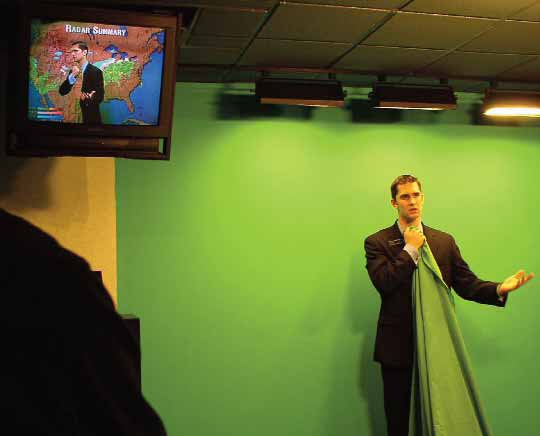SEJournal Online is the digital news magazine of the Society of Environmental Journalists. Learn more about SEJournal Online, including submission, subscription and advertising information.

E-Reporting Biz
By BUD WARD
And why that matters for the coverage of climate change
Recently, a thread arose on the SEJ-Talk listserve when a reporter asked the seemingly innocent question “Are television meteorologists environmental journalists?” Like any good question (and all not-so-good questions?), the answer is Yes. No. Maybe … and it depends.
Meteorologists’ largest credentialing professional society, the American Meteorological Society, aims to see them become “station scientists,” the go-to news persons on staff who presumably could steer other TV reporters straight on issues ranging from tomorrow’s weather to the next century’s climate; from aeronomy and agronomy to astronomy (but not astrology); from atmospheric chemistry to aquatic biology; from limnology to forest ecology. You get the picture, even if they might never.
Which brings up a subject nearly always in the news, the weather. The nexus between climate and weather is a hot topic in the many “framing” discussions constantly under way in the climate change science and communications fields nowadays. (Ink-in-vein journalist types need not apologize for being suspicious that some of this “framing” talk amounts to little more than traditional pull-the-wool public relations. They’re right. But not all of it, and that’s a reason they should pay heed to these considerations and keep an eye on them, with all due and appropriate journalistic skepticism.)
Going beyond the standard meme
Many in the climate science community, and in particular those generally viewed as being among the most respected in that community, are themselves struggling with how best to parse details involving the relationship between our warming climate and the trends toward more and more severe weather “anomalies” (the preferred term of art in the field).
Some in the science community appear ready to go beyond the standard meme: that no single weather event can be tied directly to global warming. The emerging meme may be more along these lines: no single weather event can be tied directly to global warming, but emerging patterns appear consistent with what the best science has said might happen in a warming world. And add in: The changing climate, as best symbolized by increasing atmospheric concentrations of CO2, is the new and influential background on which emerging weather events are occurring.
It’s just this issue that is discussed at length in a 2011 journal report “Changing the Media Discussion on Climate and ExtremeWeather.” The academic authors of that article — Christine Shearer of the University of California Santa Barbara and Richard Rood of the University of Michigan — praise reporters who “directly or indirectly reframe the question from ‘did climate change cause this weather event?’ toward ‘how are human-generated emissions affecting physical conditions in ways that can manifest both over the long term (climate) and the short term (weather)?’”
They urge scientists to help move reporters in this direction “given the politicization of climate change science where scientific uncertainty is often mischaracterized and promoted as an excuse for inaction.”
Is ‘false balance’ dead or just on a holiday?
All of this is happening within a context where many professional societies’ annual conferences — beyond SEJ’s own, that is — echo with the message: The media by and large are blowing it on the “environmental challenge of the century” by not sufficiently informing their audiences about climate challenges and associated risks and options.
That may be a generalization many journalists actually accept, along with their non-media observers and critics.
Now take it a step further. Part of the shortcoming in today’s reporting lies with a continuing preference among too many editors to maintain what has become known as the “faux balance”— with the views of a dozen or so climate outliers presented aside the more evidence-based perspectives of the vast majority of professional climatologists and their professional organizations (American Association for the Advancement of Science, American Geophysical Union, American Meteorological Society, American Institute of Physics, Ecological Society of America; the list goes on and on).
On that point, many SEJ members indeed appear to have a substantially different take. They say, and not without hard numbers to justify their view, that the “balance bias” is pretty much behind them at this point. And has been for several years now. This group no longer sees a need to “balance” the take of the Intergovernmental Panel on Climate Change or National Academy of Sciences, for instance, with those of a former and shrill congressional staffer turned fossil-fuels shill. That’s so yesterday that even many local TV news directors no longer drink that particular flavor of Kool-Aid®.
Mind you, there’s a lurking and concerning issue out there on this one: With the continued “downsizing” of mainstream news outlets’ science and environmental beats and specialized sections, one can imagine an upcoming crop of general assignment reporters having to go through the same steep learning curve that seasoned environmental and science reporters have already surmounted. Which is to say that the ghost of balance-as-accuracy reporting may not be vanquished after all, but rather may just be in a state of suspension. Someday (and how soon, no one can be quite sure) it may return in all its News Reporting 101 vengeance.
|
|
|
Regardless whether a weather reporter is deemed a journalist or a 'station scientist,' as the American Meteorological Society encourages, all agree increased weather reporting on climate and weather is necessary. PHOTO: |
Journalists and others agree more coverage is needed
Another universal thread found in nonjournalist climate science circles — whether they be earth scientists or the increasingly active social scientists — is one on which they and reporters may again see more eye-to-eye: Not enough coverage. Period.
By now there are several hard number-crunching findings that show coverage of climate change/global warming/whatever-you-prefer-to-call-it is down, way down from the 2006/2007 high-water mark.
There are of course reasons for this, and some are reasons that roll off the tongues of those in the journalism community while perhaps seldom occurring to those beyond it: The profound revolutionary impacts on major metropolitan dailies of the Internet; the collapse of much classified advertising revenues and the economic recession generally; the overall shrinking of the “news hole” in many media, and in particular the news hole for complex and scientific issues; the pink-slipping of a number of seasoned science reporters; the move of much of the dialogue from legacy news outlets to online “new media.”
Add to those, some media and media watchers might say, these factors: From a policy standpoint, the dearth of federal and international activity creates a vacuum, and there’s not a whole lot truly “new” about most of the underlying scientific evidence.
Not enough coverage, and not enough of it made readily available to much of the general public, and not sequestered on some preach-to-the-choir web site or garroted behind a paywall. On that point, many in the media may in fact generally agree with their critics in the physical and social science/climate change communities — Wanted: More Climate Coverage.
So, are meteorologists environmental journalists? It’s for each to decide. So too is it for environmental journalists to decide the extent to which they need to better reflect some of the approaches of meteorologists. And, for that matter, of earth and social scientists when it comes to the issue of adequately informing the public at large on critical climate issues.
Bud Ward, one of the co-founders of SEJ, is editor of The Yale Forum on Climate Change & The Media, published by YaleUniversity’s School of Forestry & Environmental Studies and its Yale Project on Climate Change Communication.
* From the quarterly newsletter SEJournal, Spring 2012. Each new issue of SEJournal is available to members and subscribers only; find subscription information here or learn how to join SEJ. Past issues are archived for the public here.








 WENZDAY01 VIA FLICKR
WENZDAY01 VIA FLICKR





 Advertisement
Advertisement 




